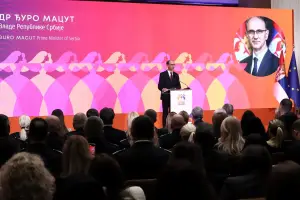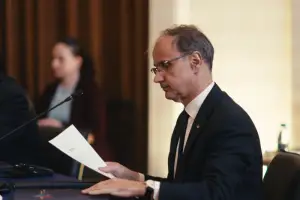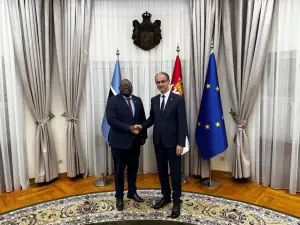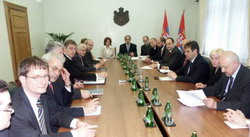- Serbia
Get to know Serbia
- Citizens
Culture and science
Health services
Pension and disability insurance
- Business
Employment
Economy
- Media
- Government
- Contact
Keep in touch
Contact form
Back
Keepin touch
Whether you have a question, comment, suggestion or any problem in the purview of the government, send us your message and we will try to respond as soon as possible. If your problem is not in our purview, we will forward your message to the relevant institution.
Q:
A:
Hungary, Serbia-Montenegro committed to European future
Belgrade,
26 May 2005
Serbian Prime Minister Vojislav Kostunica said today after a meeting with his Hungarian counterpart Ferenc Gyurcsany, with whom the Agreement on Encouraging Economic Cooperation was signed, that the state union of Serbia-Montenegro along with Hungary are both firmly committed to a European future.
Kostunica said after the meeting that the European orientation of the two countries dates back to the period before 2004 when Hungary became an EU member state, and before Serbia received a favourable assessment of the Feasibility Study.
The Serbian Prime Minister said that the talks he had today with Gyurcsany are part of wider talks that will be held in Belgrade, Pristina, Novi Sad and Subotica.
According to Kostunica, the border between Serbia and Hungary has a European quality that is reflected in its good political and economic relations that are being improved and that will be additionally encouraged by the Agreement signed today.
Kostunica said that the issues that were discussed were the projects for improving infrastructure between the two countries, such as the construction of roads on corridors 10 and 7 and the Belgrade-Budapest highway, the modernisation of railway traffic, and increasing the volume of navigation on the Danube River.
The Serbian Prime Minister said that the talks he had today with Gyurcsany are part of wider talks that will be held in Belgrade, Pristina, Novi Sad and Subotica.
According to Kostunica, the border between Serbia and Hungary has a European quality that is reflected in its good political and economic relations that are being improved and that will be additionally encouraged by the Agreement signed today.
Kostunica said that the issues that were discussed were the projects for improving infrastructure between the two countries, such as the construction of roads on corridors 10 and 7 and the Belgrade-Budapest highway, the modernisation of railway traffic, and increasing the volume of navigation on the Danube River.
The two officials also touched on the issue of improving minority rights in their respective countries. Kostunica thanked the Hungarian government for sending aid to flood-stricken areas of Central Banat. According to Kostunica, the preparation of an agreement on cooperation in the case of natural disasters was also discussed, as well as the expansion of cultural cooperation between Serbia and Hungary.
Hungarian Prime Minister Ferenc Gyurcsany said that there are no political tensions between Hungary and Serbia and added that Hungary is ready to help this region enter Euro-Atlantic integrations.
Gyurcsany said that Hungary is aware that it must put more efforts in improving relations with Serbia-Montenegro, since it is now reaching the end of the transition it has been undergoing for almost a decade and a half.
Hungarian Prime Minister Ferenc Gyurcsany said that there are no political tensions between Hungary and Serbia and added that Hungary is ready to help this region enter Euro-Atlantic integrations.
Gyurcsany said that Hungary is aware that it must put more efforts in improving relations with Serbia-Montenegro, since it is now reaching the end of the transition it has been undergoing for almost a decade and a half.
-
 Belgrade, 26 November 2025
Belgrade, 26 November 2025Macut opens Traces of Light: Serbs in the Mirror of the Hermitage exhibition
-
 Belgrade, 26 November 2025
Belgrade, 26 November 2025Young people as visionaries of future modern Serbia
-
 Novi Sad, 25 November 2025
Novi Sad, 25 November 2025Unification of Vojvodina with Serbia realisation of centuries-old dream
-
 Belgrade, 25 November 2025
Belgrade, 25 November 2025Serbia makes significant step in fight against violence against women
-
 Belgrade, 23 November 2025
Belgrade, 23 November 2025Potential for further improving cooperation between Serbia, Arab countries
-
 Belgrade/Tirana, 21 November 2025
Belgrade/Tirana, 21 November 2025Connected region best path to full EU membership
-
 Belgrade/Tirana, 21 November 2025
Belgrade/Tirana, 21 November 2025Serbia on right track in meeting EU accession criteria
-
 Belgrade, 21 November 2025
Belgrade, 21 November 2025Serbia, Botswana committed to peace, respect for international law
-
 Belgrade/Tirana, 21 November 2025
Belgrade/Tirana, 21 November 2025Prime Minister Macut at Western Balkans Leaders’ Summit
-
 Belgrade, 20 November 2025
Belgrade, 20 November 2025Serbia regional leader in growth, development of ICT services



